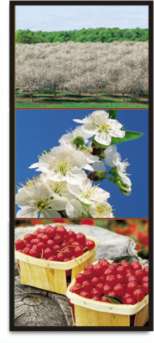|
|
|
 |
|
The Cherry Capital
| |
| Cherry orchards line the eastern
shore of Lake Michigan from Benton Harbor to the Traverse City area.
Michigan's cherry production is about 250 million pounds, and
represents about 75 percent of the tart cherries and 20 percent of the
sweet cherries grown annually in the United States.
The sandy soil and temperate weather conditions along the eastern shore of Lake Michigan are excellent for growing fruit. That's because Lake Michigan was formed during the last Ice Age, some 12,000 years ago by retreating glaciers that dug deep trenches in sandy areas that were once a sea bed. Much of that sandy soil remains along the eastern shoreline. The winds blowing from Lake Michigan help to moderate the area's weather by cooling the orchards in the summer and warming them during the winter. |
 |
A Presbyterian missionary named Peter Dougherty first had the idea to plant cherry trees in the Traverse City area in 1852. The local Indians called him "Little Beaver" because although he was a small man, he worked very hard. Everyone told him cherries wouldn't grow that far north, but Dougherty's trees flourished. Soon other area residents planted their own cherry trees. Farmers began selling their surplus cherries and that quickly created a market for cherries that seemed insatiable. As the demand for cherries increased, the farmers responded by planting more cherry trees. After Traverse City was linked by rail to Chicago and the rest of the country in 1872, more people moved to the area and took up cherry farming. By the 1880s large amounts of cherries were being shipped by boat to Chicago and Milwaukee. Michigan was blessed with rich forests and during the early development of the state, lumber was the dominant industry. As the lumber industry stripped the hills surrounding Traverse City, farmers moved in and replanted the hills with cherry orchards. In 1893, Ridgewood Farm, the area's first commercial cherry orchard was planted near the site of Dougherty's original orchard. Other's followed and by the turn of the 20th century, cherries had become the area's most important crop. Tons of cherries were being shipped all over the country via refrigerated train cars. The first cherry processing facility, Traverse City Canning Company was built just south of Traverse City. In 1925, the first Cherry Festival was held in Traverse City to generate publicity and expand the cherry market. It worked like a charm and as demand continued to increase, many more orchards were planted along the eastern shore of Lake Michigan. Today, Michigan has about 3.8 million tart cherry trees and about 0.5 million sweet cherry trees. Sweet or Tart?Sweet cherries are grown primarily for fresh eating and the sweet
cherry varieties grown in Michigan include Emperor Francis, Napoleon,
and Schmidt. Maraschino cherries, used most often to top off ice cream
sundaes or to dress up a cocktail, are made from sweet cherries. The
process for making maraschino cherries isn't very appetizing, but the
end result is quite tasty. Sweet cherries are bleached in a brine
solution of one percent sulfur dioxide and one-half percent unslaked
lime for four to six weeks to remove most of the color. After that, they
are pitted and bleached again with sodium chlorite. Then they are soaked
in fresh water for a couple of days before sugar, red dyes, and an
almond flavoring are added. The Health Benefits of CherriesSince ancient times, cherry pits have been used to relieve a number
of ailments including chest pains, stomach and intestinal spasms, throat
irritation, and even labor pains. The Cherry Pit SpitIn 1974, Herb Teichman, an Eau Claire, Michigan cherry farmer, was
looking for something to do and decided to organize a cherry-spitting
competition with a few of his friends. The event quickly grew from a
neighborhood get-together to an international competition, recognized by
the Guinness Book of World Records.
Cherry Facts
|
|



